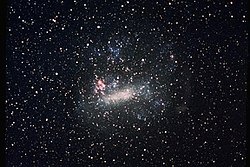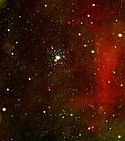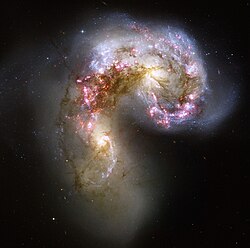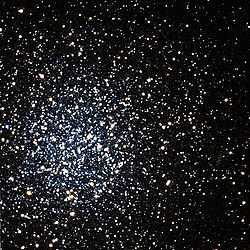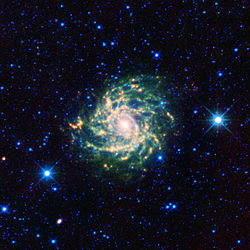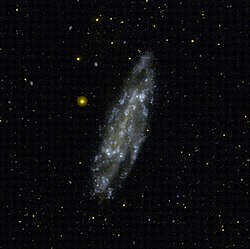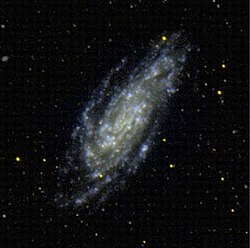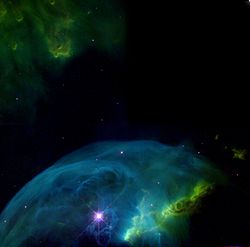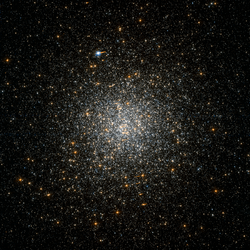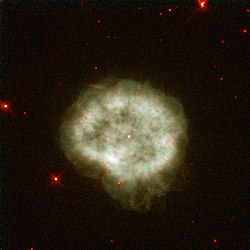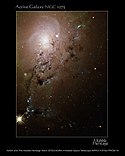Spitzer-TarantulaNebula
NASA's new Spitzer Space Telescope, formerly known as the Space Infrared Telescope Facility, has captured in stunning detail the spidery filaments and newborn stars of the Tarantula Nebula, a rich star-forming region also known as 30 Doradus. This cloud of glowing dust and gas is located in the Large Magellanic Cloud, the nearest galaxy to our own Milky Way, and is visible primarily from the Southern Hemisphere. This image of an interstellar cauldron provides a snapshot of the complex physical processes and chemistry that govern the birth - and death - of stars.
At the heart of the nebula is a compact cluster of stars, known as R136, which contains very massive and young stars. The brightest of these blue supergiant stars are up to 100 times more massive than the Sun, and are at least 100,000 times more luminous. These stars will live fast and die young, at least by astronomical standards, exhausting their nuclear fuel in a few million years.
The Spitzer Space Telescope image was obtained with an infrared array camera that is sensitive to invisible infrared light at wavelengths that are about ten times longer than visible light. In this four-color composite, emission at 3.6 microns is depicted in blue, 4.5 microns in green, 5.8 microns in orange, and 8.0 microns in red. The image covers a region that is three-quarters the size of the full moon.
The Spitzer observations penetrate the dust clouds throughout the Tarantula to reveal previously hidden sites of star formation. Within the luminescent nebula, many holes are also apparent. These voids are produced by highly energetic winds originating from the massive stars in the central star cluster. The structures at the edges of these voids are particularly interesting. Dense pillars of gas and dust, sculpted by the stellar radiation, denote the birthplace of future generations of stars.
The Spitzer image provides information about the composition of the material at the edges of the voids. The surface layers closest to the massive stars are subject to the most intense stellar radiation. Here, the atoms are stripped of their electrons, and the green color of these regions is indicative of the radiation from this highly excited, or 'ionized,' material. The ubiquitous red filaments seen throughout the image reveal the presence of molecular material thought to be rich in hydrocarbons.
The Tarantula Nebula is the nearest example of a 'starburst' phenomenon, in which intense episodes of star formation occur on massive scales. Most starbursts, however, are associated with dusty and distant galaxies. Spitzer infrared observations of the Tarantula provide astronomers with an unprecedented view of the lifecycle of massive stars and their vital role in regulating the birth of future stellar and planetary systems.| This file is in the public domain in the United States because it was solely created by NASA. NASA copyright policy states that "NASA material is not protected by copyright unless noted". (See Template:PD-USGov, NASA copyright policy page or JPL Image Use Policy.) |  | |
 |
Warnings:
|
Relevantní obrázky
Relevantní články
Mlhovina TarantuleMlhovina Tarantule je velmi velká, pouhým okem viditelná emisní mlhovina. Nachází se v severovýchodní části Velkého Magellanova oblaku, jde o nejjasnější objekt v této nepravidelné galaxii. Název dostala podle svého vzhledu, připomíná pavouka – tarantuli. Nejprve byla kategorizována jako hvězda; že jde o mlhovinu, určil 5. prosince 1751 francouzský astronom Nicolas-Louis de Lacaille. .. pokračovat ve čtení
Velký Magellanův oblakVelký Magellanův oblak nebo též Velké Magellanovo mračno je nejjasnější galaxií viditelnou z naší Galaxie. Je to trpasličí nepravidelná galaxie na hranici souhvězdí Tabulové hory a Mečouna vzdálená asi 170 000 ly. Struktura této galaxie je nepravidelná, v jejím středu je však zřetelný náznak galaktické příčky. Jedná se o velmi nápadný objekt – po Mléčné dráze jde o nejrozsáhlejší objekt na nebeské sféře viditelný pouhým okem. .. pokračovat ve čtení
Caldwellův katalogCaldwellův katalog je astronomický katalog 109 jasných hvězdokup, mlhovin a galaxií pro pozorování amatérskými astronomy. Katalog sestavil Sir Patrick Caldwell-Moore jako doplněk Messierova katalogu. .. pokračovat ve čtení



